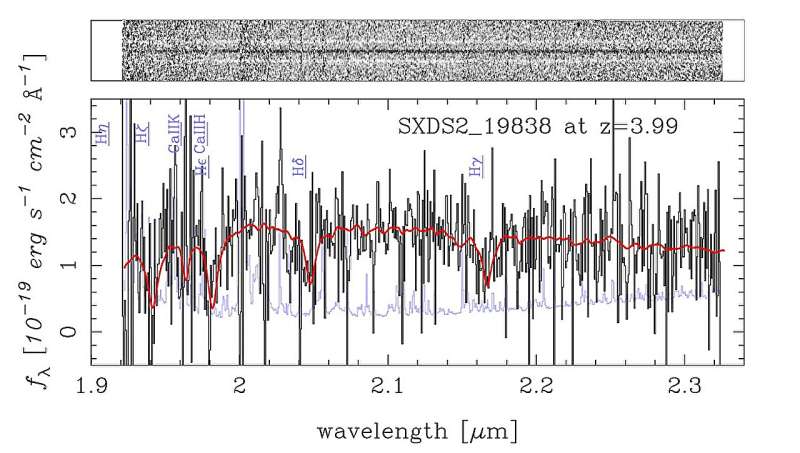November 28, 2023 report
This article has been reviewed according to Science X's editorial process and policies. Editors have highlighted the following attributes while ensuring the content's credibility:
fact-checked
preprint
trusted source
proofread
New protocluster of massive quiescent galaxies discovered

An international team of astronomers reports the discovery of a new protocluster of massive quiescent galaxies at a redshift of approximately 4.0. This is the first detection of a protocluster of this type at such a high redshift. The finding was detailed in a paper published Nov. 20 on the pre-print server arXiv.
Galaxy clusters harbor from hundreds to thousands of galaxies bound together by gravity. They are the most immense gravitationally bound structures in the universe, and could serve as excellent laboratories for studying galaxy evolution and cosmology.
Astronomers are especially interested in studies of protoclusters of galaxies, the progenitors of clusters. Such objects, found at high redshifts (over 2.0), could provide essential information about the early phases of the universe.
Now, a group of astronomers led by Masayuki Tanaka of the National Astronomical Observatory of Japan (NAOJ) has found a new high-redshift protocluster. By analyzing the data from the Subaru/XMM-Newton Deep Survey (SDXS), they identified a concentration of at least five massive quiescent galaxies, at a redshift of 3.99. The study was complemented by data from follow-up observations with the MOSFIRE spectrograph on the Keck I telescope.
The newfound galaxies received designations: SXDS2_19838, SXDS2_15659, SXDS2_16609, SXDS2_19229, and SXDS2_19997. The galaxy SXDS2_19838 is the most massive of them as its stellar mass and halo mass were measured to be 113.1 billion and 3.1 trillion solar masses, respectively.
The observations show that SXDS2_19838 is surrounded by four other galaxies, which together have stellar and halo masses, of about 230 billion and 8.5 trillion solar masses, respectively. All the galaxies of this overdensity experienced recently an episode of starburst activity, followed by a rapid quenching. Now, they have star-formation rates (SFRs) between 1.4 and 11.5 solar masses per year.
The collected data suggest that all these five galaxies formed and quenched at similar times. The authors of the paper assume that this protocluster will collapse to form the core of a massive cluster. They added that the protocluster may be a denser system than observed, and that the member galaxies are not yet in the same halo at the time of the observation, but further studies are needed to confirm it.
Summing up the results, the researchers underline how unique their discovery is. "This is the first discovery of a concentration of quiescent galaxies at this high redshift and it serves as a unique laboratory to investigate the role of the environment at z = 4 for the first time," the scientists concluded.
More information: Masayuki Tanaka et al, A proto-cluster of massive quiescent galaxies at z=4, arXiv (2023). DOI: 10.48550/arxiv.2311.11569
Journal information: arXiv
© 2023 Science X Network


















